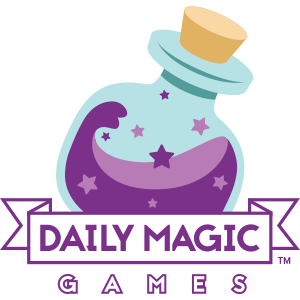Amarynth Rising Playtest Report
/The Bank from Thieves Den
Over the weekend we were able to bring out one of our newer designs, Amarynth Rising, for the first time in public. This is somewhat of a reimagining of Sunrise City, which was the first design Isaias Vallejo had published. It was originally released by Clever Mojo Games, which was owned by David MacKenzie before Daily Magic Games was born. So, as you can see, the original game holds a special place in our hearts.
Isaias has been wanting to revisit the game but in a much more fundamental way than what an expansion is capable of. More like a tearing down and rethinking of all the systems and mechanisms. Most notably, the goal is to streamline everything. The new game should be more approachable, faster, and easier to teach. The original is great, but the new version should land squarely in the “gateway +” or, at most, medium weight category.
The game’s setting is now in Amarynth, the same land that we’ve seen in Thieve’s Den and 10 Minute Heist. Amarynth has also made a cameo in the Valeria: Card Kingdoms - Crimson Seas and Quests of Valeria. Amarynth is a Victorian era fantasy realm where magic, thieving, and corruption reign.
The new mechanisms in Amarynth Rising actually work really well with that theme since the new version was created with that environment in mind. The game now has only two primary mechanisms: tile laying and worker placement (kind of— more on that later), though set collecting is important for scoring. Instead of multiple phases and rounds that split up player turns like in Sunrise City, now players take 2 specific actions each turn and the game progresses until the stack of tiles runs out. This was one of the most important changes that Isaias wanted to make. Specifically, he wanted to simplify the overall flow of the game. It still has the system that if a player lands exactly on “10” coins they score 2 points instead of the single point that they would get just by passing it. This is one of the coolest parts of Sunrise City and feels like an integral part of what makes players constantly engaged.
The goal of Amarynth Rising is to score the most points and points are gained, as mentioned previously, by players collecting 10 or more coins. Players gain coins primarily by laying down building tiles of various colored districts attempting to match the same color(s) as tiles previously played. Players gain 1 coin for each connected district of the same type(s) as the tile that they just played. So if a player lays down a tile that has a blue and a red district, they would count how many contiguous blue AND red districts their tile is connected to. Often the first inclination of a new player might be to just make as large of districts as possible to score a lot of coins. However, since landing exactly on 10 is twice as rewarding as just passing it by, the real goal is not necessarily to get as many coins as possible but instead to use precision to figure out how best to hit the sweet spot. Landing on other numbers can be rewarding too since there are other bonuses to be had, but that’s a secondary consideration.
Each turn players must place exactly 1 tile and then move their ‘Founder’ (which is quite similar to a worker) to a new spot to meet with a new ‘Bureaucrat’ and take their associated action (much like a worker placement location). Players can optionally also try out a little bit of Bribery. Bribes are extra actions that are randomly placed out at the start of the game under each Bureaucrat. The types of actions that can be taken through Bribes or by normal means include things like gaining more tiles, gaining a flat amount of coins, moving a thief around the map, or placing a ‘city tile’ (which scores a little differently than a normal tile). If a player doesn’t like the assigned Bribery action for each official, they can alternatively turn in sets of treasure tokens that can be gained from the various tiles that players are placing around the map. This option is an important part of the game that can award quite a number of points if focused on.
We played several games in this outing and the feedback was really quite positive, especially for a first public showing. After each test, players were eager to play it again to try out different strategies and during the after-game debrief there was already talk about what expansion content could look like. The main constructive criticism revolved around making sure that the number of available treasure tokens was correct, making sure that the iconography art was more distinct, and balancing some of the point values on things like the secret end-game goals. The core gameplay and decisions that players made each turn seemed to be fun and engaging for everyone, which is a great sign!
We will continue to tweak and tune the numbers so that everything feels fair and properly rewarding. Another playtest report will likely happen as we get more public eyes on it and especially if any significant changes are made to the core game play.
Remember, if you’d like to keep hearing more about games in development or just want to stay in the loop on game launches, sales, and where we’ll to show our games, just sign up for our newsletter.




